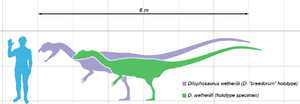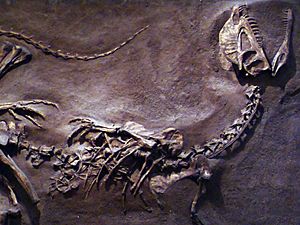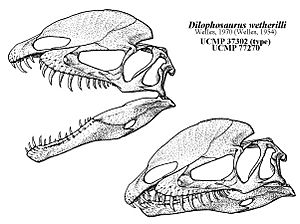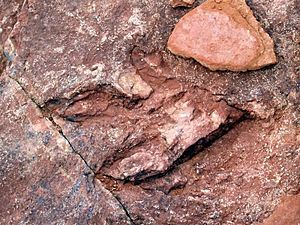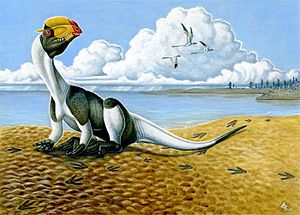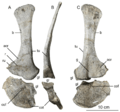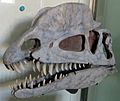Dilophosaurus facts for kids
Quick facts for kids DilophosaurusTemporal range: Lower Jurassic
|
|
|---|---|
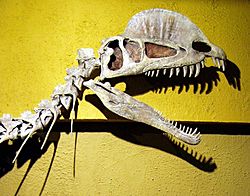 |
|
| Reconstruction of a Dilophosaurus skull | |
| Scientific classification | |
| Kingdom: | |
| Class: | |
| Superorder: | |
| Order: | |
| Suborder: | |
| Family: |
Dilophosauridae
|
| Genus: |
Dilophosaurus
|
Dilophosaurus means 'double-crested lizard'. It was a medium-sized dinosaur that lived about 190 million years ago. Scientists think it was a carnivore, meaning it ate meat. Its fossils have been found in areas that used to be slow-moving rivers.
Scientists have studied Dilophosaurus many times. They have placed it in different groups of theropod dinosaurs. It might be related to the smaller dinosaur called Coelophysis.
Contents
What Did Dilophosaurus Look Like?
Dilophosaurus was about 7 metres (23 ft) long. It weighed around 400 kilograms (880 lb). That's about as heavy as a small car!
This dinosaur had long teeth. The teeth were smaller at the front of its upper jaw. It had a special notch behind its first row of teeth. This made its jaw look a bit like a crocodile's. Some scientists think this means it might have eaten fish.
A study in 2005 looked at different Dilophosaurus fossils. It found no signs that males and females looked very different. This means both sexes probably had similar skeletons.
The Skull Crests
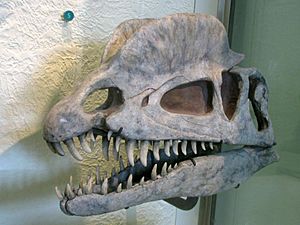
The most special thing about Dilophosaurus is the two rounded crests on its head. These crests were made of bone from its nose and eye areas. Scientists believe these crests were too thin and delicate to be used for fighting. They were likely just for show.
Scientists have wondered about the purpose of these crests. They might have been used to attract mates. Or perhaps they helped dinosaurs of the same species recognize each other. This is called intra-species recognition.
Discovery and Different Species
The first Dilophosaurus fossils were found in 1942. Sam Welles discovered them in Arizona. A Navajo man named Jesse Williams had found the site in 1940. Three dinosaur skeletons were found, but one was too damaged.
Two skeletons were taken to the University of California, Berkeley. They were cleaned and put together. At first, in 1954, Welles named them Megalosaurus wetherilli. The name honored John Wetherill, who explored the area.
In 1964, Welles found a new skeleton. This one had the unique double crests. He realized it was very different from Megalosaurus. So, in 1970, he gave it a new name: Dilophosaurus. This name comes from Greek words meaning "two-crested lizard." The first two skeletons found were likely young dinosaurs.
In 2001, Robert J. Gay found more Dilophosaurus fossils. These included parts of the hip bones. They also found a very young Dilophosaurus specimen. This baby fossil helps scientists learn about how early dinosaurs grew.
Other Species of Dilophosaurus?
A second species, Dilophosaurus sinensis, was found in China in 1987. It was bigger and stronger than D. wetherilli. However, later studies showed that this species was actually a different dinosaur called Sinosaurus triassicus.
A third species, D. breedorum, was suggested in 1999. This was based on the skeleton found in 1964. However, most scientists do not accept this as a separate species. They think it was just an adult Dilophosaurus wetherilli.
How Dilophosaurus Lived
Dilophosaurus walked on two legs. Its back legs were long and strong. Its front legs were short and not used for walking. This suggests it was a fast and agile runner, like other meat-eating theropods.
Some scientists thought Dilophosaurus might have lived in small groups. This was because several fossils were found together. But others argue that floods could have washed different dinosaurs together. The crests on their heads would make sense if they lived in groups. Other dinosaurs could see and understand messages about their status.
What Did Dilophosaurus Eat?
Early ideas suggested that Dilophosaurus was a scavenger. This means it ate dead animals. Some thought its jaw was too weak to hunt large prey. This was because of the loose connection in its upper jaw.
More recently, some researchers think Dilophosaurus might have eaten fish. This idea comes from its crocodile-like jaw and similarities to other fish-eating dinosaurs. Also, some dinosaur tracks found near its fossils look like swimming tracks.
How Did Dilophosaurus Grow?
A study in 1996 looked at the bones of Dilophosaurus. It suggested that these dinosaurs grew very quickly when they were young. They could gain almost 35 kilograms (77 lb) in their early life.
Injuries and Health
One Dilophosaurus fossil shows a damaged back bone. This injury might have happened during its life. Another fossil had an unusually small left arm compared to its right arm. This could mean it had problems during its growth.
A specific Dilophosaurus specimen (UCMP 37302) had many injuries. It had bone tumors, broken and healed bones on both arms, and deformed fingers. It also couldn't use one of its front limbs properly. Scientists believe these injuries happened in a fight or accident. The dinosaur would have been in a lot of pain while healing.
In 2001, scientists checked 60 foot bones from Dilophosaurus. They looked for signs of stress fractures, but found none.
Dinosaur Footprints
In Arizona, dinosaur footprints called Kayentapus hopii and Dilophosauripus williamsi have been found. Scientists believe these three-toed tracks were made by Dilophosaurus. Similar tracks have also been found in Poland and Sweden. Some tracks in Sweden even suggest these dinosaurs lived in herds.
A very interesting footprint was found in Massachusetts. It was a "dinosaur sitting imprint." This is where a dinosaur rested its body on the ground. At first, some thought lines around the imprint were feathers. This would mean Dilophosaurus had feathers. But later, it was found that these lines were just cracks in the mud. So, we don't have direct proof of feathers on Dilophosaurus yet.
Tracks called Eubrontes and Gigandipus have been found in the Connecticut River Valley. These tracks are often thought to be from Dilophosaurus. No Dilophosaurus fossils have been found directly with these tracks. But their size and shape match what a Dilophosaurus would make.
Where Dilophosaurus Lived
The main Dilophosaurus fossils were found in the Kayenta Formation in Arizona. This area was a slow-moving river system about 196 to 183 million years ago. The Kayenta Formation is part of a larger group of rocks found in Arizona, Utah, Colorado, and New Mexico.
Many other creatures lived in the Kayenta Formation. These include plants, snails, and other small animals. Scientists have also found fossils of other dinosaurs there.
Dilophosaurus remains have also been found in India. These fossils were discovered in mudstone from about 196 to 189 million years ago. Other fossils found there include a crocodile and another dinosaur called Lamplughsaura dharmaramensis.
Dilophosaurus in Movies
Dilophosaurus is famous from the 1990 novel Jurassic Park and the 1993 movie adaptation. In the movie, it is shown as being able to spit venom to blind its prey. It also has a frill around its neck, like a frill-necked lizard.
It's important to know that there is no scientific proof for the venom or the neck frill. The author, Michael Crichton, said these were made up for the story. In the movie, director Steven Spielberg also made Dilophosaurus smaller. This was so people wouldn't confuse it with Velociraptor.
Dilophosaurus has been named the state dinosaur of Connecticut.
Images for kids
-
Map showing localities in northern Arizona where Dilophosaurus fossils have been collected (squares)
-
Life restoration showing hypothetical feathers and crest-shape
-
Cast of Coelophysis, with which Dilophosaurus has often been grouped, Redpath Museum
-
Reconstructed skeleton of the crested Cryolophosaurus, sometimes considered a close relative of Dilophosaurus
-
Skull bones of Dracovenator, which may have been a close relative of Dilophosaurus (onto whose skull the bones are plotted), ROM
-
Diagrams of Late Triassic-Early Jurassic tracks, several of which have been attributed to theropods similar to Dilophosaurus, including Eubrontes (A), Dilophosauripus (E), and Kayentapus (F)
-
Cast in Japan of a resting trace from Massachusetts, which was argued to have been made by a theropod like Dilophosaurus and to include feather impressions around the belly (arrow), but this has been questioned
-
Scapula of Sarahsaurus with a probable tooth mark on its outer surface (C) possibly left by a scavenging Dilophosaurus
-
Reconstructed skull showing possibly outdated crest-shape, American Museum of Natural History
-
Restoration of an adult tending to its hatching clutch
-
Restoration of Dilophosaurus chasing Scutellosaurus
-
Models showing Jurassic Park style neck frills and outdated hand postures, Nong Nooch Dinosaur Valley
See also
 In Spanish: Dilophosaurus wetherilli para niños
In Spanish: Dilophosaurus wetherilli para niños


